Research Progress of Copper-Based Bimetallic Electrocatalytic Reduction of CO2
Abstract
:1. Introduction
2. Electrocatalytic Reduction of CO2
2.1. Transition Metal Catalytic Reduction
2.2. Cu Atom Modified Substrate Catalysis
2.3. Cu Cluster–Modified Substrate Catalysis
3. Cu-Based Bimetallic Electrocatalytic Reduction of CO2
3.1. Cu-Ag
3.2. Cu-Au
3.3. Cu-Zn
3.4. Cu-Ni
4. Conclusions and Prospects
Author Contributions
Funding
Conflicts of Interest
References
- Li, K.; Peng, B.; Peng, T.Y. Recent advances in heterogeneous photocatalytic CO2 conversion to solar fuels. ACS Catal. 2016, 6, 7485–7527. [Google Scholar] [CrossRef]
- Inoue, T.; Fujishima, A.; Konishi, S.; Honda, K. Photoelectrocatalytic reduction of carbon dioxide in aqueous suspensions of semiconductor powders. Nature 1979, 277, 637–638. [Google Scholar] [CrossRef]
- Xiong, Z.; Lei, Z.; Xu, Z.W.; Chen, X.X.; Gong, B.G.; Zhao, Y.C.; Zhao, H.B.; Zhang, J.Y.; Zheng, C.G. Flame spray pyrolysis synthesized ZnO/CeO2 nanocomposites for enhanced CO2 photocatalytic reduction under UV–Vis light irradiation. J. CO2 Util. 2017, 18, 53–61. [Google Scholar] [CrossRef]
- Pan, Y.X.; Sun, Z.Q.; Cong, H.P.; Men, Y.L.; Xin, S.; Song, J.; Yu, S.H. Photocatalytic CO2 reduction highly enhanced by oxygen vacancies on Pt-nanoparticle-dispersed gallium oxide. Nano Res. 2016, 9, 1689–1700. [Google Scholar] [CrossRef]
- Senftle, T.P.; Lessio, M.; Carter, E.A. Interaction of pyridine and water with the reconstructed surfaces of GaP(111) and CdTe(111) photoelectrodes: Implications for CO2 reduction. Chem. Mater. 2016, 28, 5799–5810. [Google Scholar] [CrossRef]
- Yang, Y.H.; Zhan, F.Q.; Li, H.; Liu, W.H.; Yu, S. In Situ Sn-doped WO3 films with enhanced photoelectrochemical performance for reducing CO2 into formic acid. J. Solid State Electrochem. 2017, 21, 2231–2240. [Google Scholar] [CrossRef]
- Lo, C.C.; Hung, C.H.; Yuan, C.S.; Wu, J.F. Photoreduction of carbon dioxide with H2 and H2O over TiO2 and ZrO2 in a circulated photocatalytic reactor. Sol. Energy Mater. Sol. Cells 2007, 91, 1765–1774. [Google Scholar] [CrossRef]
- Kočí, K.; Praus, P.; Edelmannová, M.; Ambrožová, N.; Troppová, L.; Fridrichová, D.; Słowik, G.; Ryczkowski, J. Photocatalytic reduction of CO2 over CdS, ZnS and core/shell CdS/ZnS nanoparticles deposited on montmorillonite. J. Nanosci. Nanotechnol. 2017, 17, 4041–4047. [Google Scholar] [CrossRef]
- Ali, A.; Oh, W.C. A simple ultrasono-synthetic route of PbSe-graphene-TiO2 ternary composites to improve the photocatalytic reduction of CO2. Fuller. Nanotub. Carbon Nanostruct. 2017, 25, 449–458. [Google Scholar] [CrossRef]
- Wang, Y.W.; Xin, F.; Chen, J.S.; Xiang, T.Y.; Yin, X.H. Photocatalytic reduction of CO2 in isopropanol on Bi2S3 quantum dots/TiO2 nanosheets with exposed {001} facets. J. Nanosci. Nanotechnol. 2017, 17, 1863–1869. [Google Scholar] [CrossRef]
- Ohno, T.; Murakami, N.; Koyanagi, T.; Yang, Y. Photocatalytic reduction of CO2 over a hybrid photocatalyst composed of WO3 and graphitic carbon nitride (g-C3N4) under visible light. J. CO2 Util. 2014, 6, 17–25. [Google Scholar] [CrossRef]
- Tahir, M.; Amin, N.S. Indium-doped TiO2 nanoparticles for photocatalytic CO2 reduction with H2O vapors to CH4. Appl. Catal. B Environ. 2015, 162, 98–109. [Google Scholar] [CrossRef]
- Bharath, G.; Prakash, J.; Rambabu, K.; Devanand Venkatasubbu, G.; Kumar, A.; Lee, S.; Theerthagiri, J.; Choi, M.Y.; Banat, F. Synthesis of TiO2/RGO with plasmonic Ag nanoparticles for highly efficient photoelectrocatalytic reduction of CO2 to methanol toward the removal of an organic pollutant from the atmosphere. Environ. Pollut. 2021, 281, 116990. [Google Scholar] [CrossRef]
- Rosen, J.; Hutchings, G.S.; Lu, Q.; Forest, R.V.; Moore, A.; Jiao, F. Electrodeposited Zn dendrites with enhanced CO selectivity for electrocatalytic CO2 reduction. ACS Catal. 2015, 5, 4586–4591. [Google Scholar] [CrossRef]
- Back, S.; Kim, J.H.; Kim, Y.T.; Jung, Y. On the mechanism of high product selectivity for HCOOH using Pb in CO2 electroreduction. Phys. Chem. Chem. Phys. 2016, 18, 9652–9657. [Google Scholar] [CrossRef]
- Weng, Z.; Zhang, X.; Wu, Y.S.; Huo, S.J.; Jiang, J.B.; Liu, W.; He, G.J.; Liang, Y.Y.; Wang, H.L. Self-cleaning catalyst electrodes for stabilized CO2 reduction to hydrocarbons. Angew. Chem. 2017, 129, 13315–13319. [Google Scholar] [CrossRef]
- Hussain, J.; Jónsson, H.; Skúlason, E. Faraday efficiency and mechanism of electrochemical surface reactions: CO2 reduction and H2 formation on Pt(111). Faraday Discuss. 2016, 195, 619–636. [Google Scholar] [CrossRef]
- Hori, Y.; Kikuchi, K.; Suzuki, S. Production of CO and CH4 in electrochemical reduction of CO2 at metal electrodes in aqueous hydrogencarbonate solution. Chem. Lett. 1985, 14, 1695–1698. [Google Scholar] [CrossRef]
- Garza, A.J.; Bell, A.T.; Head-Gordon, M. Mechanism of CO2 reduction at copper surfaces: Pathways to C2 products. ACS Catal. 2018, 8, 1490–1499. [Google Scholar] [CrossRef]
- Goodpaster, J.D.; Bell, A.T.; Head-Gordon, M. Identification of possible pathways for C–C bond formation during electrochemical reduction of CO2: New theoretical insights from an improved electrochemical model. J. Phys. Chem. Lett. 2016, 7, 1471–1477. [Google Scholar] [CrossRef]
- Calle-Vallejo, F.; Koper, M.T.M. Theoretical considerations on the electroreduction of CO to C2 species on Cu(100) electrodes. Angew. Chem. Int. Ed. 2013, 125, 7423–7426. [Google Scholar] [CrossRef]
- Li, H.J.; Li, Y.D.; Koper, M.T.M.; Calle-Vallejo, F. Bond-making and breaking between carbon, nitrogen, and oxygen in electrocatalysis. J. Am. Chem. Soc. 2014, 136, 15694–15701. [Google Scholar] [CrossRef] [PubMed]
- Bu, Y.F.; Zhao, M.; Zhang, G.X.; Zhang, X.G.; Gao, G.; Jiang, Q. Electroreduction of CO2 on Cu clusters: The effects of size, symmetry, and temperature. ChemElectroChem 2019, 6, 1831–1837. [Google Scholar] [CrossRef]
- Wang, Z.N.; Yang, G.; Zhang, Z.R.; Jin, M.S.; Yin, Y.D. Selectivity on etching: Creation of high-energy facets on copper nanocrystals for CO2 electrochemical reduction. ACS Nano 2016, 10, 4559–4564. [Google Scholar] [CrossRef]
- Reske, R.; Mistry, H.; Behafarid, F.; Cuenya, B.R.; Strasser, P. Particle size effects in the catalytic electroreduction of CO2 on Cu nanoparticles. J. Am. Chem. Soc. 2014, 136, 6978–6986. [Google Scholar] [CrossRef]
- Li, Q.; Mahmood, N.; Zhu, J.H.; Huo, Y.L.; Sun, S.H. Graphene and its composites with nanoparticles for electrochemical energy applications. Nano Today 2014, 9, 668–683. [Google Scholar] [CrossRef]
- Manthiram, K.; Beberwyck, B.J.; Alivisatos, A.P. Enhanced electrochemical methanation of carbon dioxide with a dispersible nanoscale copper catalyst. J. Am. Chem. Soc. 2014, 136, 13319–13325. [Google Scholar] [CrossRef]
- Hoang, T.T.H.; Ma, S.; Gold, J.I.; Kenis, P.J.A.; Gewirth, A.A. Nanoporous copper films by additive-controlled electrodeposition: CO2 reduction catalysis. ACS Catal. 2017, 7, 3313–3321. [Google Scholar] [CrossRef]
- Huan, T.N.; Simon, P.; Rousse, G.; Génois, I.; Artero, V.; Fontecave, M. Porous dendritic copper: An electrocatalyst for highly selective CO2 reduction to formate in water/ionic liquid electrolyte. Chem. Sci. 2017, 8, 742–747. [Google Scholar] [CrossRef]
- Li, Y.; Cui, F.; Ross, M.B.; Kim, D.; Sun, Y.; Yang, P. Structure-sensitive CO2 electroreduction to hydrocarbons on ultrathin 5-fold twinned copper nanowires. Nano Lett. 2017, 17, 1312–1317. [Google Scholar] [CrossRef]
- Zhu, G.Z.; Li, Y.W.; Zhu, H.Y.; Su, H.B.; Chan, S.H.; Sun, Q. Enhanced CO2 electroreduction on armchair graphene nanoribbons edge-decorated with copper. Nano Res. 2017, 10, 1641–1650. [Google Scholar] [CrossRef]
- Passalacqua, R.; Parathoner, S.; Centi, G.; Halder, A.; Tyo, E.C.; Yang, B.; Seifert, S.; Vajda, S. Electrochemical behaviour of naked sub-nanometre sized copper clusters and effect of CO2. Catal. Sci. Technol. 2016, 6, 6977–6985. [Google Scholar] [CrossRef]
- Iyemperumal, S.K.; Deskins, N.A. Activation of CO2 by supported Cu clusters. Phys. Chem. Chem. Phys. 2017, 19, 28788–28807. [Google Scholar] [CrossRef]
- Shen, H.M.; Li, Y.W.; Sun, Q. Cu atomic chains supported on β-borophene sheets for effective CO2 electroreduction. Nanoscale 2018, 10, 11064–11071. [Google Scholar] [CrossRef]
- Du, D.C.; Zhu, H.Y.; Guo, Y.N.; Hong, X.L.; Zhang, Q.S.; Sou, B.B.; Zou, W.L.; Li, Y.W. Anchoring Cu Clusters over Defective Graphene for Electrocatalytic Reduction of CO2. J. Phys. Chem. C 2022, 126, 11611–11618. [Google Scholar] [CrossRef]
- Ni, Z.Y.; Liang, H.M.; Yi, Z.Y.; Guo, R.; Liu, C.M.; Liu, Y.G.; Sun, H.Y.; Liu, X.W. Research progress of electrochemical CO2 reduction for copper-based catalysts to multicarbon products. Coord. Chem. Rev. 2021, 441, 213983. [Google Scholar] [CrossRef]
- Wang, H.L.; Zhou, X.J.; Yu, T.S.; Lu, X.L.; Qian, L.H.; Liu, P.; Lei, P.X. Surface restructuring in AgCu single-atom alloy catalyst and self-enhanced selectivity toward CO2 reduction. Electrochim. Acta 2022, 426, 140774. [Google Scholar] [CrossRef]
- Clark, E.L.; Hahn, C.; Jaramillo, T.F.; Bell, A.T. Electrochemical CO2 reduction over compressively strained CuAg surface alloys with enhanced multi-carbon oxygenate selectivity. J. Am. Chem. Soc. 2017, 139, 15848–15857. [Google Scholar] [CrossRef]
- Ishimaru, S.; Shiratsuchi, R.; Nogami, G. Pulsed Electroreduction of CO2 on Cu-Ag Alloy Electrodes. J. Electrochem. Soc. 2000, 147, 1864. [Google Scholar] [CrossRef]
- Huang, J.F.; Mensi, M.; Oveisi, E.; Mantella, V.; Buonsanti, R. Structural sensitivities in bimetallic catalysts for electrochemical CO2 reduction revealed by Ag–Cu nanodimers. J. Am. Chem. Soc. 2019, 141, 2490–2499. [Google Scholar] [CrossRef]
- Wang, Y.X.; Niu, C.L.; Zhu, Y.C. Copper–silver bimetallic nanowire arrays for electrochemical reduction of carbon dioxide. Nanomaterials 2019, 9, 173. [Google Scholar] [CrossRef] [PubMed]
- Chang, Z.Y.; Huo, S.J.; Zhang, W.; Fang, J.H.; Wang, H.L. The tunable and highly selective reduction products on Ag@Cu bimetallic catalysts toward CO2 electrochemical reduction reaction. J. Phys. Chem. C 2017, 121, 11368–11379. [Google Scholar] [CrossRef]
- Jeon, Y.; Choi, I.; Kim, J.J. Facile electrochemical fabrication of Ag/Cu bi-metallic catalysts and the dependence of their selectivity for electrochemical CO2 reduction on the surface composition. Thin Solid Films 2021, 726, 138674. [Google Scholar] [CrossRef]
- Wang, J.Q.; Li, Z.; Dong, C.K.; Feng, Y.; Yang, J.; Liu, H.; Du, X.W. Silver/copper interface for relay electroreduction of carbon dioxide to ethylene. ACS Appl. Mater. Interfaces 2019, 11, 2763–2767. [Google Scholar] [CrossRef] [PubMed]
- Jeon, Y.E.; Ko, Y.N.; Kim, J.; Choi, H.; Lee, W.; Kim, Y.E.; Lee, D.; Kim, H.Y.; Park, K.T. Selective production of ethylene from CO2 over CuAg tandem electrocatalysts. J. Ind. Eng. Chem. 2022, 116, 191–198. [Google Scholar] [CrossRef]
- Wang, L.; Yang, J.C. Enhanced nucleation and decreased growth rates of Cu2O in Cu0.5Au0.5 (001) thin films during In Situ oxidation. J. Mater. Res. 2005, 20, 1902–1909. [Google Scholar] [CrossRef]
- Pace, S.; Hoof, T.V.; Hou, M.; Buess-Herman, C.; Reniers, F. Surface composition of CuAu single crystal electrodes determined by a coupled UHV–electrochemical approach and a Monte-Carlo simulation. Surf. Interface Anal. 2004, 36, 1078–1082. [Google Scholar] [CrossRef]
- Christophe, J.; Doneux, T.; Buess-Herman, C. Electroreduction of carbon dioxide on copper-based electrodes: Activity of copper single crystals and copper–gold alloys. Electrocatalysis 2012, 3, 139–146. [Google Scholar] [CrossRef]
- Kim, D.; Resasco, J.; Yu, Y.; Asiri, A.M.; Yang, P.D. Synergistic geometric and electronic effects for electrochemical reduction of carbon dioxide using gold–copper bimetallic nanoparticles. Nat. Commun. 2014, 5, 4948. [Google Scholar] [CrossRef]
- Xu, Z.C.; Lai, E.; Shao-Horn, Y.; Hamad-Schifferli, K. Compositional dependence of the stability of AuCu alloy nanoparticles. Chem. Commun. 2012, 48, 5626–5628. [Google Scholar] [CrossRef]
- Liu, X.Y.; Wang, A.Q.; Wang, X.D.; Mou, C.Y.; Zhang, T. Au–Cu alloy nanoparticles confined in SBA-15 as a highly efficient catalyst for CO oxidation. Chem. Commun. 2008, 27, 3187–3189. [Google Scholar] [CrossRef]
- Zhang, X.G.; Feng, S.S.; Zhan, C.; Wu, D.Y.; Zhao, Y.; Tian, Z.Q. Electroreduction reaction mechanism of carbon dioxide to C2 products via Cu/Au bimetallic catalysis: A theoretical prediction. J. Phys. Chem. Lett. 2020, 11, 6593–6599. [Google Scholar] [CrossRef]
- Feng, H.S.; Chen, C.Y.; Wang, S.; Zhang, M.; Ding, H.; Liang, Y.J.; Zhang, X. Theoretical Investigation of Cu–Au Alloy for Carbon Dioxide Electroreduction: Cu/Au Ratio Determining C1/C2 Selectivity. J. Phys. Chem. Lett. 2022, 13, 8002–8009. [Google Scholar] [CrossRef]
- Won, D.H.; Shin, H.; Koh, J.; Chung, J.; Lee, H.S.; Kim, H.; Woo, S.I. Highly efficient, selective, and stable CO2 electroreduction on a hexagonal Zn catalyst. Angew. Chem. Int. Ed. 2016, 128, 9443–9446. [Google Scholar] [CrossRef]
- Ren, D.; Ang, B.S.H.; Yeo, B.S. Tuning the selectivity of carbon dioxide electroreduction toward ethanol on oxide-derived CuxZn catalysts. ACS Catal. 2016, 6, 8239–8247. [Google Scholar] [CrossRef]
- Yin, G.; Abe, H.; Kodiyath, R.; Ueda, S.; Srinivasan, N.; Yamaguchi, A.; Miyauchi, M. Selective electro-or photo-reduction of carbon dioxide to formic acid using a Cu–Zn alloy catalyst. J. Mater. Chem. A 2017, 5, 12113–12119. [Google Scholar] [CrossRef]
- Feng, Y.; Li, Z.; Liu, H.; Dong, C.K.; Wang, J.Q.; Kulinich, S.A.; Du, X.W. Laser-prepared CuZn alloy catalyst for selective electrochemical reduction of CO2 to ethylene. Langmuir 2018, 34, 13544–13549. [Google Scholar] [CrossRef]
- Zeng, J.Q.; Rino, T.; Bejtka, K.; Castellino, M.; Sacco, A.; Farkhondehfal, M.A.; Chiodoni, A.; Drago, F.; Pirri, C.F. Coupled Copper–Zinc Catalysts for Electrochemical Reduction of Carbon Dioxide. ChemSusChem 2020, 13, 4128–4139. [Google Scholar] [CrossRef]
- Li, C.W.; Kanan, M.W. CO2 reduction at low overpotential on Cu electrodes resulting from the reduction of thick Cu2O films. J. Am. Chem. Soc. 2012, 134, 7231–7234. [Google Scholar] [CrossRef]
- Zhang, T.T.; Zhong, H.X.; Qiu, Y.L.; Li, X.F.; Zhang, H.M. Zn electrode with a layer of nanoparticles for selective electroreduction of CO2 to formate in aqueous solutions. J. Mater. Chem. A 2016, 4, 16670–16676. [Google Scholar] [CrossRef]
- Hu, H.J.; Tang, Y.; Hu, Q.; Wan, P.Y.; Dai, L.M.; Yang, X.J. In-situ grown nanoporous Zn-Cu catalysts on brass foils for enhanced electrochemical reduction of carbon dioxide. Appl. Surf. Sci. 2018, 445, 281–286. [Google Scholar] [CrossRef]
- Jeon, H.S.; Timoshenko, J.; Scholten, F.; Sinev, I.; Herzog, A.; Haase, F.T.; Cuenya, B.R. Operando insight into the correlation between the structure and composition of CuZn nanoparticles and their selectivity for the electrochemical CO2 reduction. J. Am. Chem. Soc. 2019, 141, 19879–19887. [Google Scholar] [CrossRef] [PubMed]
- Juntrapirom, S.; Santatiwongchai, J.; Watwiangkham, A.; Suthirakun, S.; Butburee, T.; Faungnawakij, K.; Chakthranont, P.; Hirunsit, P.; Rungtaweevoranit, B. Tuning CuZn interfaces in metal–organic framework-derived electrocatalysts for enhancement of CO2 conversion to C2 products. Catal. Sci. Technol. 2021, 11, 8065–8078. [Google Scholar] [CrossRef]
- Wan, L.L.; Zhang, X.L.; Cheng, J.S.; Chen, R.; Wu, L.X.; Shi, J.W.; Luo, J.S. Bimetallic Cu–Zn Catalysts for Electrochemical CO2 Reduction: Phase-Separated versus Core–Shell Distribution. ACS Catal. 2022, 12, 2741–2748. [Google Scholar] [CrossRef]
- Tan, D.X.; Zhang, J.L.; Cheng, X.Y.; Tan, X.N.; Shi, J.B.; Zhang, B.X.; Han, B.X.; Zheng, L.R.; Zhang, J. CuxNiy alloy nanoparticles embedded in a nitrogen–carbon network for efficient conversion of carbon dioxide. Chem. Sci. 2019, 10, 4491–4496. [Google Scholar] [CrossRef]
- Ding, C.M.; Li, A.L.; Lu, S.M.; Zhang, H.F.; Li, C. In Situ electrodeposited indium nanocrystals for efficient CO2 reduction to CO with low overpotential. ACS Catal. 2016, 6, 6438–6443. [Google Scholar] [CrossRef]
- Asadi, M.; Kim, K.; Liu, C.; Addepalli, A.V.; Abbasi, P.; Yasaei, P.; Phillips, P.; Behranginia, A.; Cerrato, J.M.; Haasch, R.; et al. Nanostructured transition metal dichalcogenide electrocatalysts for CO2 reduction in ionic liquid. Science 2016, 353, 467–470. [Google Scholar] [CrossRef]
- Oh, Y.; Hu, X.L. Organic molecules as mediators and catalysts for photocatalytic and electrocatalytic CO2 reduction. Chem. Soc. Rev. 2013, 42, 2253–2261. [Google Scholar] [CrossRef]
- Varela, A.S.; Sahraie, N.R.; Steinberg, J.; Ju, W.; Oh, H.S.; Strasser, P. Metal-doped nitrogenated carbon as an efficient catalyst for direct CO2 electroreduction to CO and hydrocarbons. Angew. Chem. Int. Ed. 2015, 54, 10758–10762. [Google Scholar] [CrossRef]
- Ding, C.M.; Feng, C.C.; Mei, Y.H.; Liu, F.Y.; Wang, H.; Dupuis, M.; Li, C. Carbon nitride embedded with transition metals for selective electrocatalytic CO2 reduction. Appl. Catal. B Environ. 2020, 268, 118391. [Google Scholar] [CrossRef]
- Sachtler, W.M.H.; Dorgelo, G.J.H. The surface of copper-nickel alloy films: I. Work function and phase composition. J. Catal. 1965, 4, 654–664. [Google Scholar] [CrossRef]
- Zhang, X.L.; Liu, C.W.; Zhao, Y.; Li, L.B.; Chen, Y.; Raziq, F.; Qiao, L.; Guo, S.X.; Wang, C.Y.; Wallace, G.G.; et al. Atomic nickel cluster decorated defect-rich copper for enhanced C2 product selectivity in electrocatalytic CO2 reduction. Appl. Catal. B Environ. 2021, 291, 120030. [Google Scholar] [CrossRef]
- Yin, Z.Y.; Yu, J.Q.; Xie, Z.H.; Yu, S.W.; Zhang, L.Y.; Akauola, T.; Chen, J.G.; Huang, W.Y.; Qi, L.; Zhang, S. Hybrid Catalyst Coupling Single-Atom Ni and Nanoscale Cu for Efficient CO2 Electroreduction to Ethylene. J. Am. Chem. Soc. 2022, 144, 20931–20938. [Google Scholar] [CrossRef]
- Luo, Z.C.; Yin, Z.Y.; Yu, J.Q.; Yu, Y.; Hu, B.; Nie, R.F.; Kolln, A.F.; Wu, X.; Behera, R.K.; Chen, M.; et al. General Synthetic Strategy to Ordered Mesoporous Carbon Catalysts with Single-Atom Metal Sites for Electrochemical CO2 Reduction. Small 2022, 18, 2107799. [Google Scholar] [CrossRef]
- Luo, Z.C.; Nie, R.F.; Nguyen, V.T.; Biswas, A.; Behera, R.K.; Wu, X.; Kobayashi, T.; Sadow, A.; Wang, B.; Huang, W.Y.; et al. Transition metal-like carbocatalyst. Nat. Commun. 2020, 11, 4091. [Google Scholar] [CrossRef]
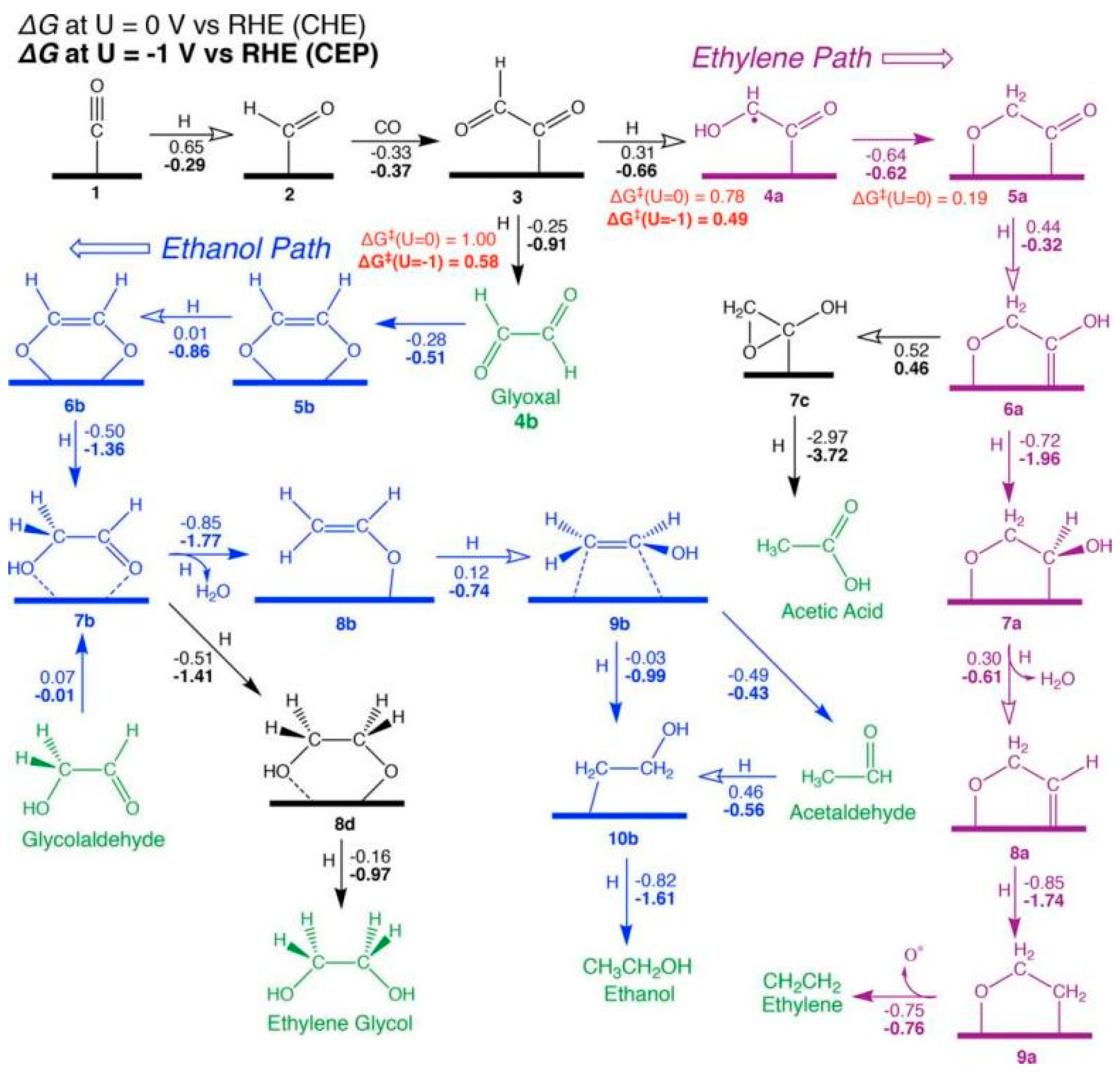
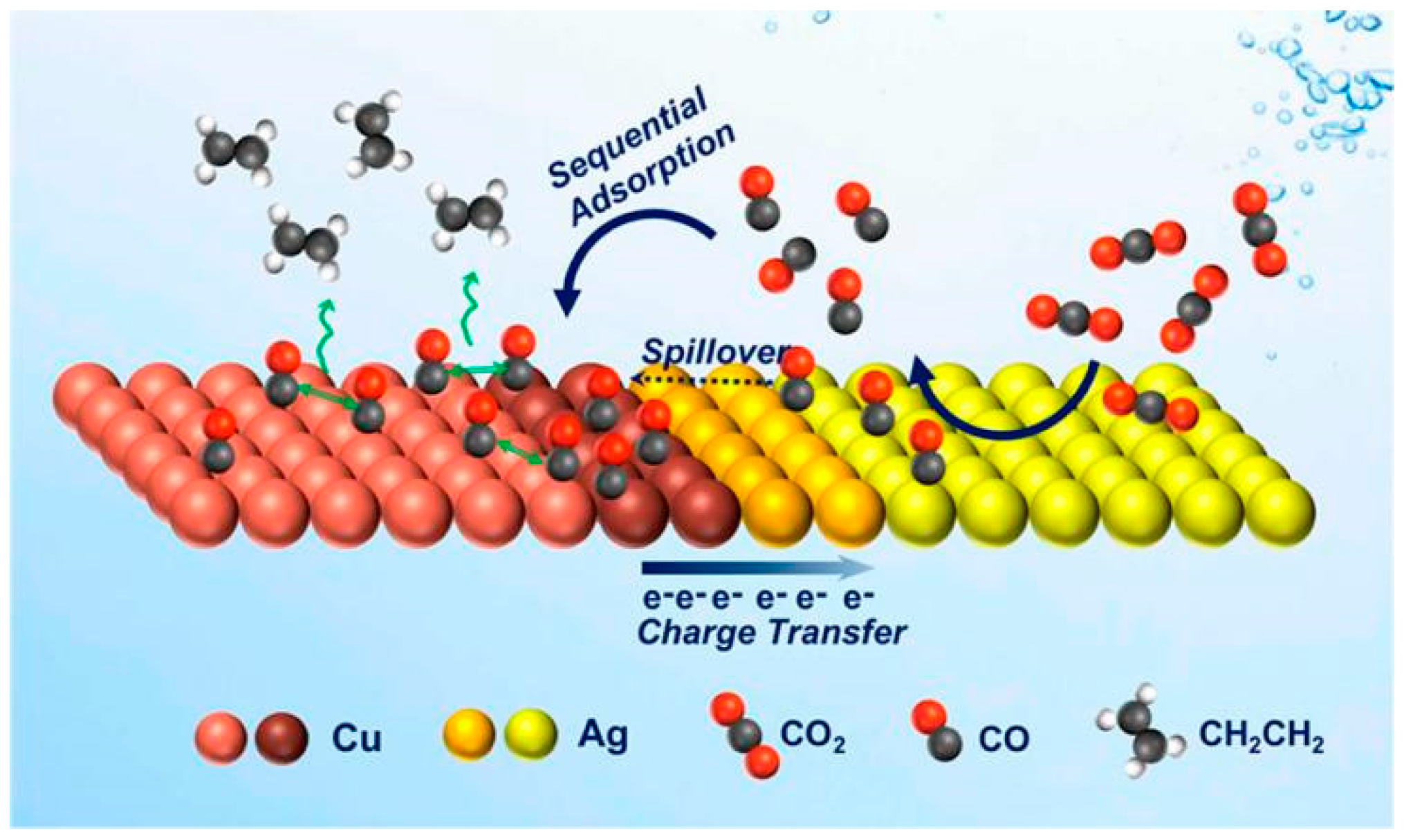

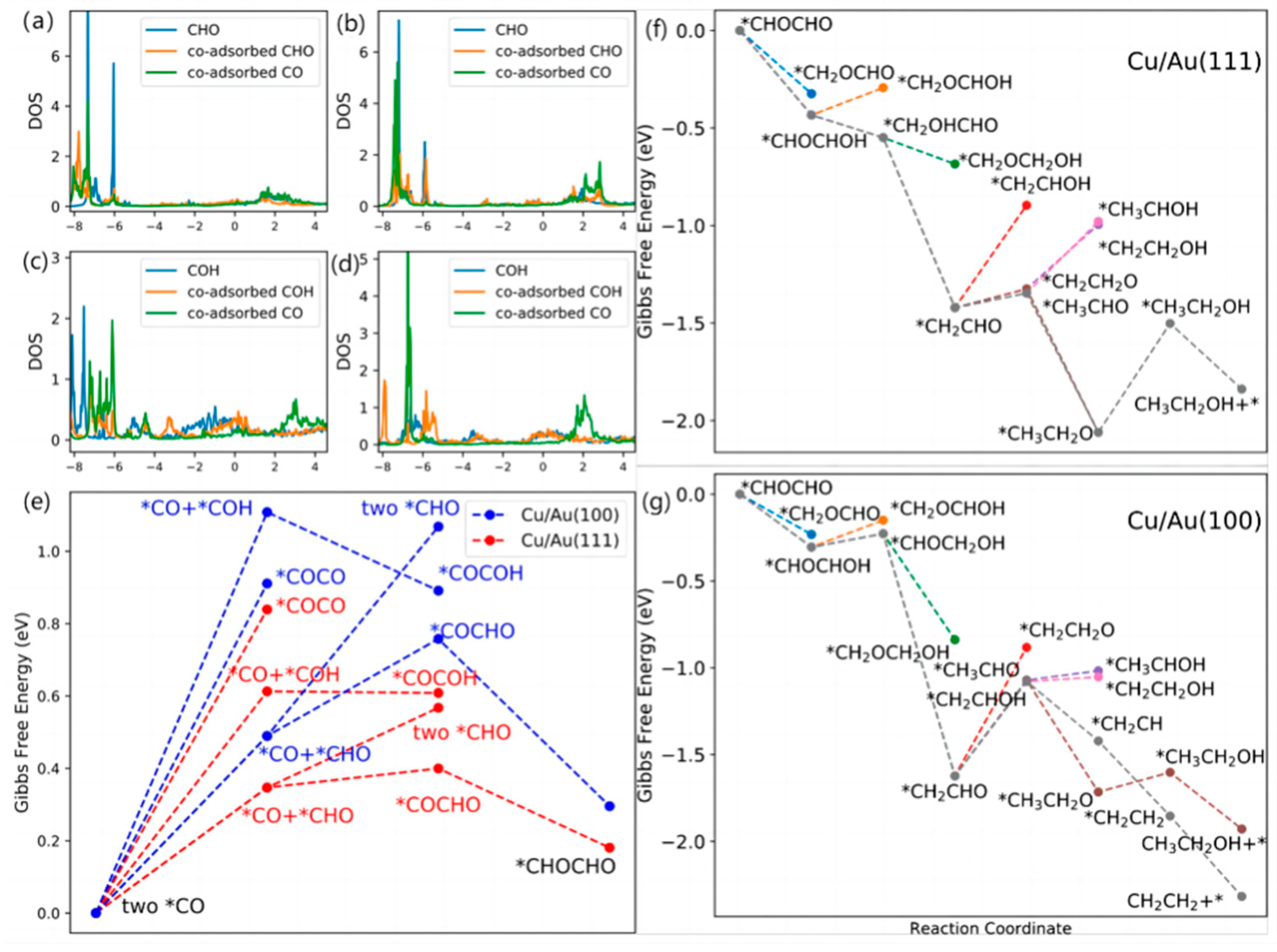
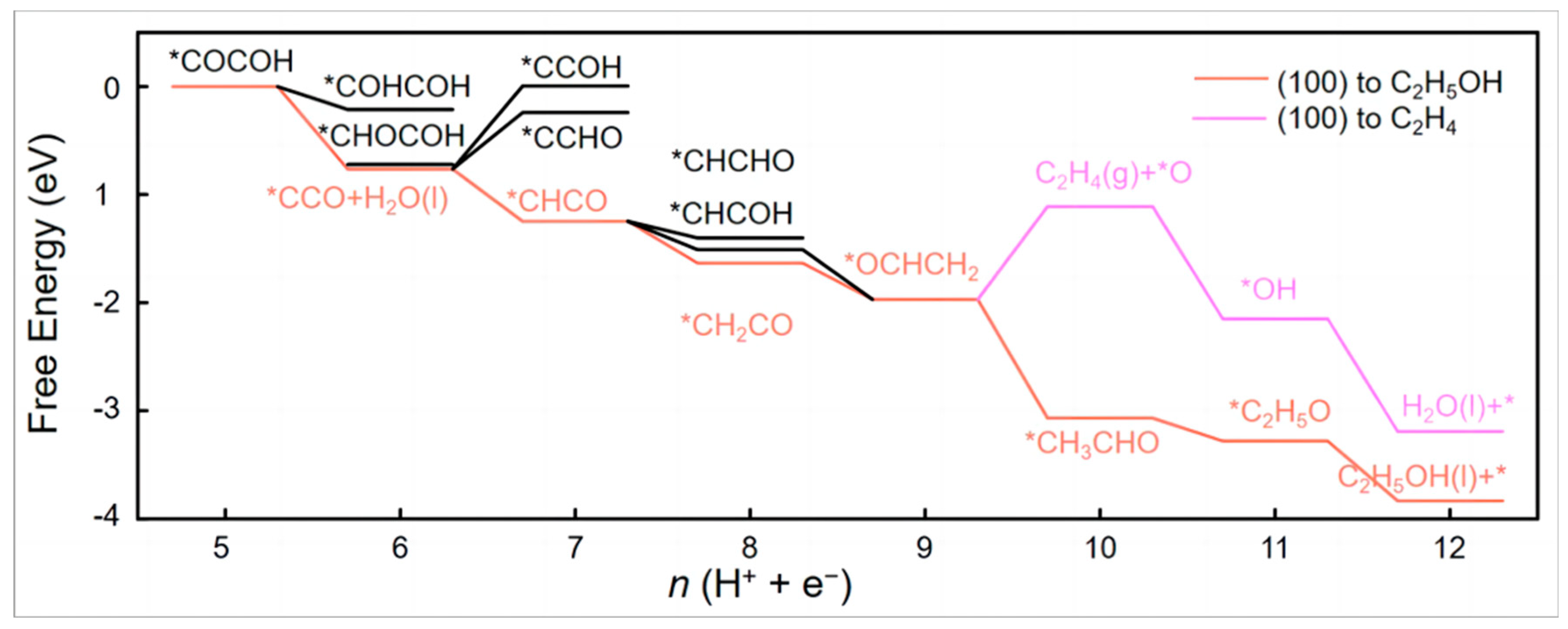


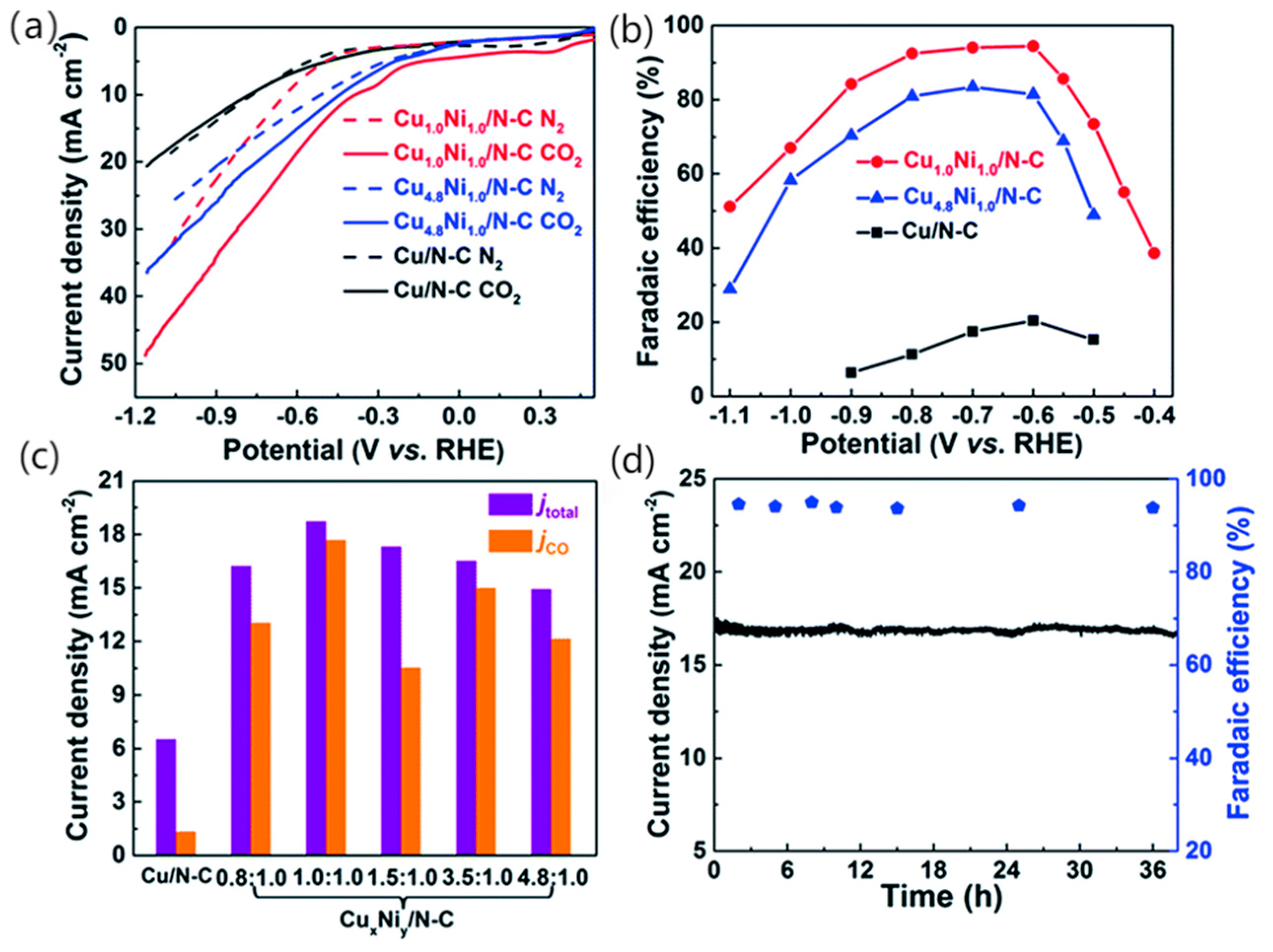


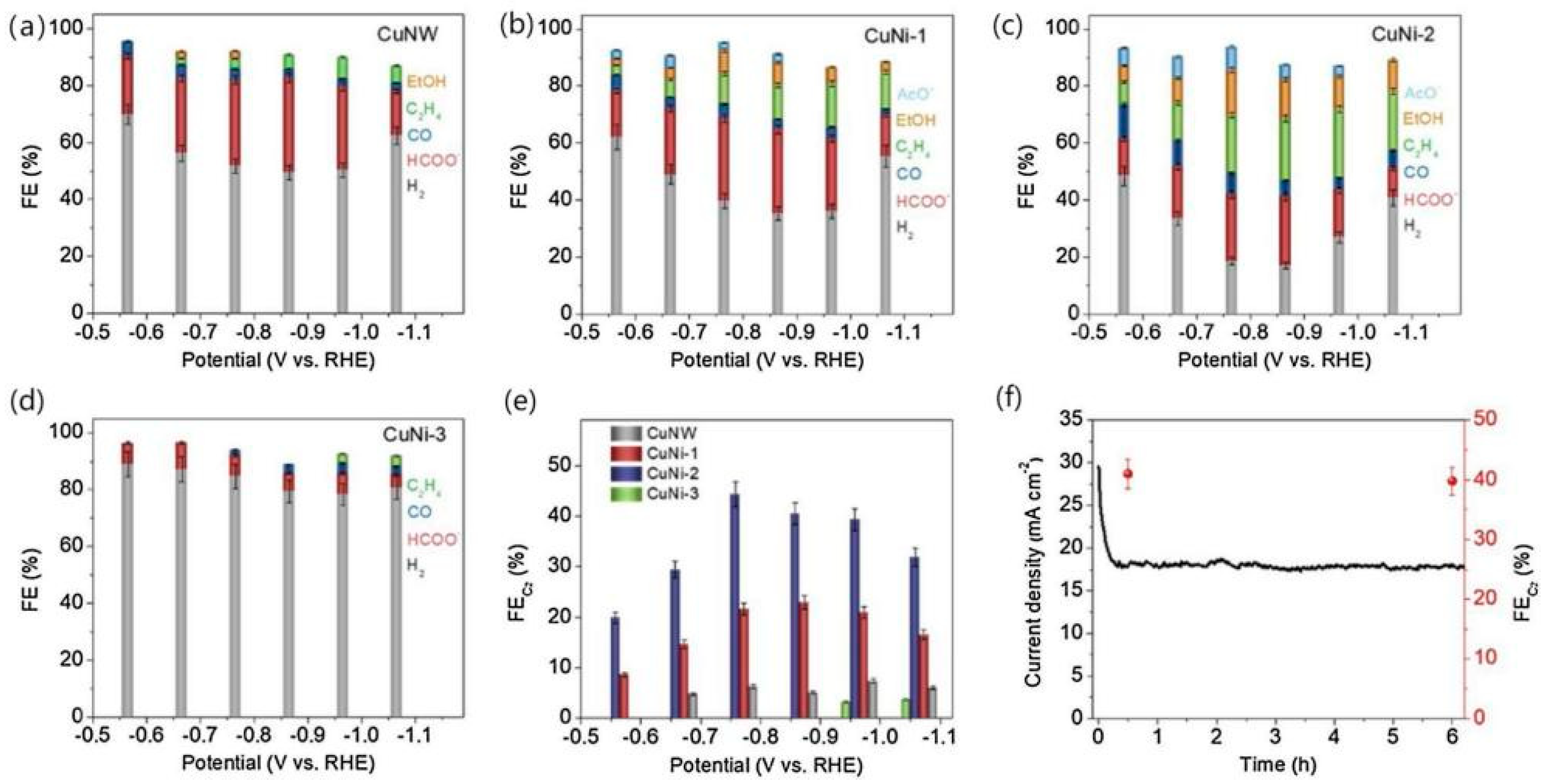
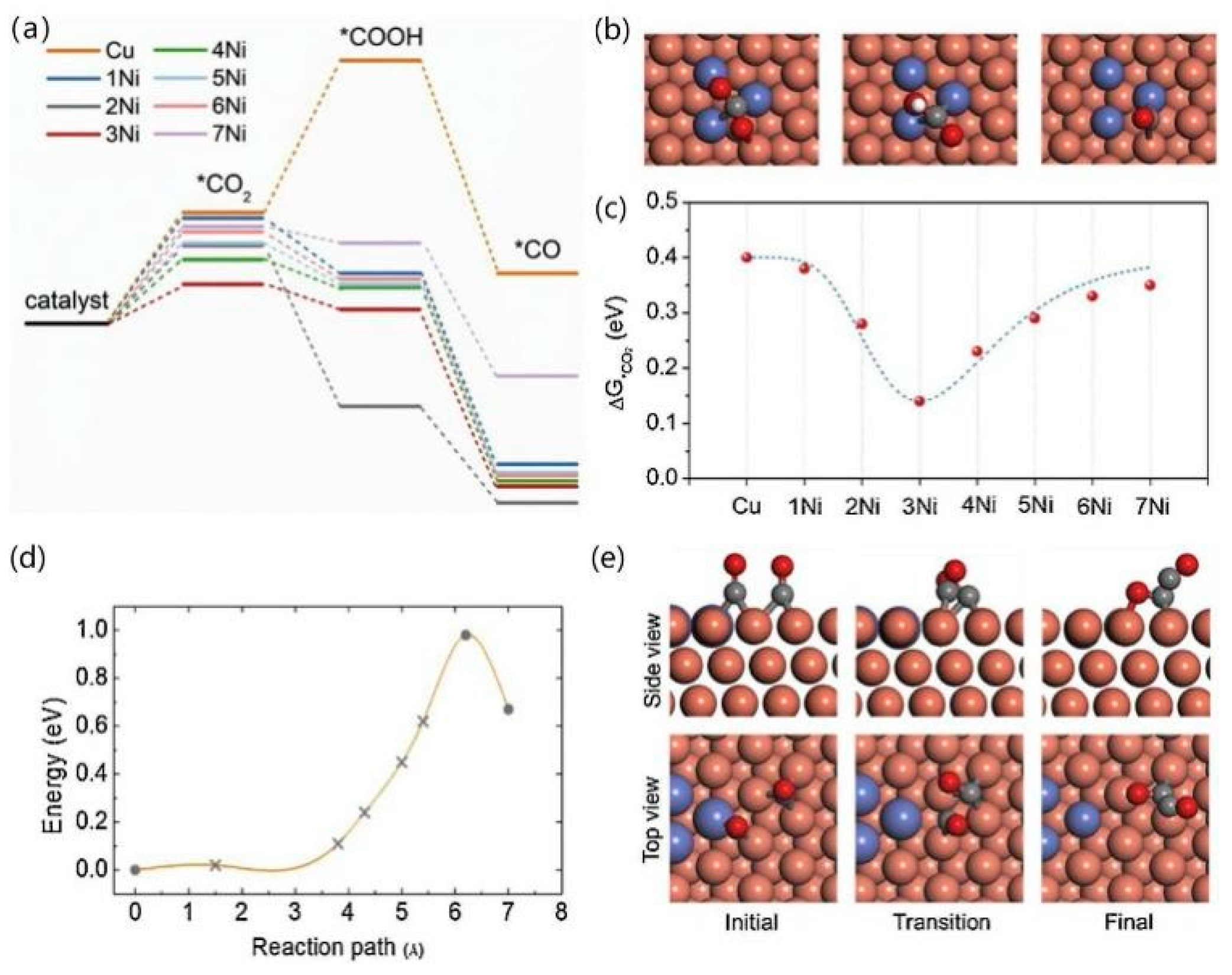
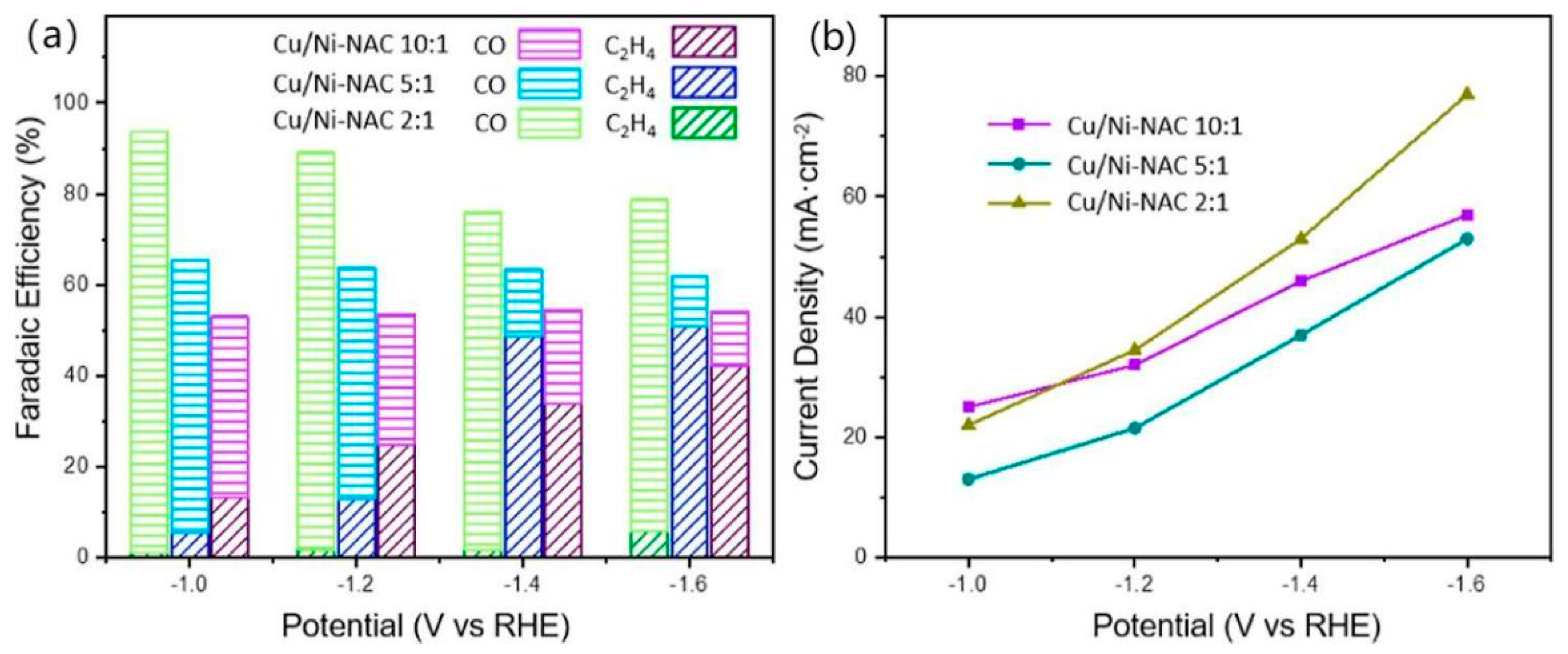
Disclaimer/Publisher’s Note: The statements, opinions and data contained in all publications are solely those of the individual author(s) and contributor(s) and not of MDPI and/or the editor(s). MDPI and/or the editor(s) disclaim responsibility for any injury to people or property resulting from any ideas, methods, instructions or products referred to in the content. |
© 2023 by the authors. Licensee MDPI, Basel, Switzerland. This article is an open access article distributed under the terms and conditions of the Creative Commons Attribution (CC BY) license (https://creativecommons.org/licenses/by/4.0/).
Share and Cite
Hong, X.; Zhu, H.; Du, D.; Zhang, Q.; Li, Y. Research Progress of Copper-Based Bimetallic Electrocatalytic Reduction of CO2. Catalysts 2023, 13, 376. https://doi.org/10.3390/catal13020376
Hong X, Zhu H, Du D, Zhang Q, Li Y. Research Progress of Copper-Based Bimetallic Electrocatalytic Reduction of CO2. Catalysts. 2023; 13(2):376. https://doi.org/10.3390/catal13020376
Chicago/Turabian StyleHong, Xiaolei, Haiyan Zhu, Dianchen Du, Quanshen Zhang, and Yawei Li. 2023. "Research Progress of Copper-Based Bimetallic Electrocatalytic Reduction of CO2" Catalysts 13, no. 2: 376. https://doi.org/10.3390/catal13020376
APA StyleHong, X., Zhu, H., Du, D., Zhang, Q., & Li, Y. (2023). Research Progress of Copper-Based Bimetallic Electrocatalytic Reduction of CO2. Catalysts, 13(2), 376. https://doi.org/10.3390/catal13020376






